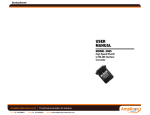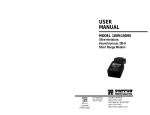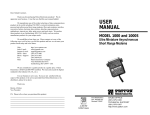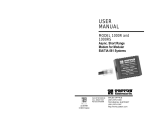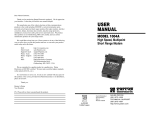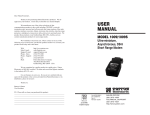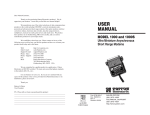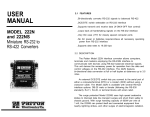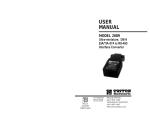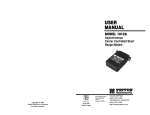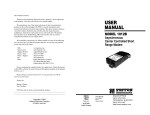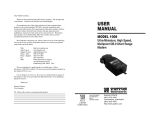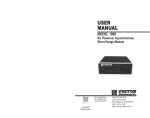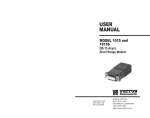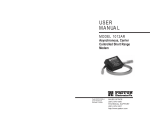Download USER MANUAL
Transcript
USER MANUAL MODEL 2085 High Speed RS-232 to RS-485 Interface Converter Part# 07M2085-D Doc# 047033UD Revised 4/15/97 CERTIFIED An ISO-9001 Certified Company 1.1 RADIO AND TV INTERFERENCE The Model 2085 generates and uses radio frequency energy, and if not installed and used properly—that is, in strict accordance with the manufacturer's instructions—may cause interference to radio and television reception. The Model 2085 has been tested and found to comply with the limits for a Class A computing device in accordance with the specifications in Subpart J of Part 15 of FCC rules, which are designed to provide reasonable protection from such interference in a commercial installation. However, there is no guarantee that interference will not occur in a particular installation. If the Model 2085 does cause interference to radio or television reception, which can be determined by disconnecting the RS-232 interface, the user is encouraged to try to correct the interference by one or more of the following measures: moving the computing equipment away from the receiver, re-orienting the receiving antenna and/or plugging the receiving equipment into a different AC outlet (such that the computing equipment and receiver are on different branches). 1.2 CE NOTICE The CE symbol on your Patton Electronics equipment indicates that it is in compliance with the Electromagnetic Compatibility (EMC) directive and the Low Voltage Directive (LVD) of the Union European (EU). A Certificate of Compliance is available by contacting Technical Support. 1 2 2.0 GENERAL INFORMATION Thank you for your purchase of this Patton Electronics product. This product has been thoroughly inspected and tested and is warranted for One Year parts and labor. 3.0 CONFIGURATION The Model 2085 is configured using an eight position DIP switch and a DCE/DTE switch. Figure 1 (below) shows the location of the DCE/DTE switch (externally accessible) on the PC board, as well as the power supply daughter board and terminal block. DCE/DTE Switch 2.1 FEATURES • Operates asynchronously, point to point or multipoint, over 2 or 4 wires • Up to 50 multipoint device drops in a polling environment • Data rates to 115.2 Kbps • Passes transmit & receive data, one control signal each direction • No AC power or batteries are required Terminal Block +RCV- G -XMT+ • Variable high/low impedance settings • Able to operate with or without “echo” • Carrier can be set as “constantly on” or “controlled by RTS” Figure 1. Top view of Model 2085 board, showing DCE/DTE switch. • Compact size ( 2.66” x 2.10” x 0.73”) • Twisted pair connection via strain relief, RJ-11 or RJ-45 • Silicon Avalanche Diode surge protection 2.2 DESCRIPTION Figure 2 (below) shows the location of the eight position DIP switch on the underside of the Model 2085 PC board. Figure 3 (following page) shows the orientation of the eight position DIP switch, with respect to ON/OFF positions. The Model 2085 High Speed RS-232 to RS-485 Interface Converter provides exceptional versatility in a compact package. Requiring no AC power or batteries for operation, the Model 2085 supports asynchronous RS-232 data rates to 115.2 Kbps over one or two unconditioned twisted pair. The Model 2085 passes one control signal in each direction and can handle up to 50 terminal drops in a multipoint polling environment. The Model 2085 may be configured for high or low impedance operation, carrier may be set to “constantly on” or “controlled by RTS”, and the unit can operate with or without “echo”. RTS/CTS delay may be set for “no delay” or 8 mS. The Model 2085 is equipped with either male or female DB-25 for RS-232 connection. Options for twisted pair connection include terminal blocks with strain relief, RJ-11, RJ-45 and DB-25 male or female. Silicon Avalanche Diodes provide 600 watts per wire of protection against harmful data line transient surges. 3 DIP Switch S1 ON 1 2 3 4 5 6 7 8 Figure 2. Bottom view of Model 2085 board, showing (internal) DIP switch. 4 ON ON 1 2 3 4 5 6 7 8 OFF 3.3 DIP SWITCH SETTINGS All possible settings for the Model 2085’s configuration switches are presented in Figure 5 (below). Following Figure 5 is a detailed description of each switch function. If you have additional questions, contact Technical Support at (301) 975-1000. Figure 3. Close-up of DIP switch showing “ON” and “OFF” positions 3.1 SETTING THE DCE/DTE SWITCH S1 SUMMARY TABLE Position Function S1-1* “Transmit Off” Impedance Off S1-2* “Transmit Off” Impedance Off S1-3 RTS/CTS Delay On 8 msec S1-4 “ECHO” Mode Off Echo Off S1-5 Carrier Control On RTS Cont. 120 Ohm For your convenience, the Model 2085 has an externally accessible DCE/DTE switch. If the device connected to the Model 2085 is a modem or multiplexer (or is wired like one), set the switch to “DTE”. This setting causes the Model 2085 to behave like Data Terminal Equipment and transmit data on pin 2. If the device connected to the Model 2085 is a PC, terminal or host computer (or is wired like one), set the switch to “DCE”. This setting causes the Model 2085 to behave like Data Communications Equipment and transmit data on pin 3. S1-6 Receive Impedance On S1-7* 2-Wire/4-Wire On S1-8* 2-Wire/4-Wire On 3.2 DIP SWITCH CONFIGURATION The eight switches on switch set S1 (see Figure 3, above) configure the Model 2085 for echo mode, carrier control method, RTS/CTS delay, “transmit off” impedance, receive impedance, and 2wire/4-wire operation. These switches are located internally on the Model 2085's PC board. To access switch set S1, use a small flat blade screwdriver to pop open the Model 2085's case as shown in Figure 4, below. Factory Default } High Z } 2-Wire Figure 5. Summary of DIP switch default settings for set S1 *Note: Switches S1-1 & S1-2 should be switched simultaneously. Switches S1-7 & S1-8 should also be switched simultaneously. S1-1 and S1-2: “Transmit Off” Impedance Switches S1-1 and S1-2 are set together to determine whether the receiving device “sees” the impedance of the Model 2085’s transmitter as being “high” or “intermediate” when the transmitter is turned off. The “intermediate” setting is useful in half-duplex environments where the receiving device does not respond well to the “high” setting. S1-1 On Off S1-2 On Off Setting Intermediate Impedance High Impedance S1-3: RTS/CTS Delay The setting for switch S1-3 determines the amount of delay between the time the Model 2085 “sees” RTS and when it sends CTS. Note: RTS/CTS Delay setting should be based upon transmission timing. Figure 4. Opening the Model 2085's plastic case with a small screwdriver 5 S1-3 On Off Setting 8 mSec no delay 6 S1-4: Echo Mode 3.4 CONFIGURATION SWITCH APPLICATIONS The setting for switch S1-4 determines whether the Model 2085 echoes data back to the transmitting device (half-duplex mode only). The switch settings generally needed to configure the Model 2085 for various applications are shown in the table below. Note: Do not change switch settings until you have carefully read Section 3.3. S1-4 On Off Setting Echo On Echo Off TYPICAL MODEL 2085 APPLICATIONS Point-to-Point Switch Settings S1-5: Carrier Control Method The setting for switch S1-5 determines whether the carrier is “Constantly On” or “Controlled by RTS”. This setting allows for operation in switched carrier, multipoint and/or hardware handshaking applications. S1-5 On Off Setting Controlled by RTS Constantly On Multi-point 4W 4W HDX 2W 4W 2W S1-1: “Xmt Off” Imp. S1-2: “Xmt Off” Imp. OFF OFF OFF OFF OFF OFF OFF OFF OFF OFF S1-3: RTS/CTS Delay ON ON ON OFF ON S1-4: Echo OFF OFF OFF OFF OFF S1-5: Carrier Control OFF ON ON Master-OFF Slaves-ON ON S1-6: Rcv Impedance ON ON ON S1-7: 2-wire/4-wire S1-8: 2-wire/4-wire OFF OFF OFF OFF ON ON S1-6: Receive Impedance The setting for switch S1-6 selects the impedance of the input receiver. You may select either a “low” impedance of 120 Ohms or a “high” impedance of 16 kOhms. By selecting the proper impedance for each drop, there may be up to 50 receivers in one application. S1-6 On Off Setting Low (120 Ohm) High (16 kOhm typical) S1-7 and S1-8: 2-Wire/4-Wire Modes Switches S1-7 and S1-8 are set together to determine whether the Model 2085 is in 2-wire or 4-wire operating mode. Note: 2-wire mode is half-duplex only. S1-7 On Off S1-8 On Off Setting 2-wire mode 4-wire mode 7 8 Master - ON Slaves - OFF Last Slave - ON OFF OFF ON ON 4.0 INSTALLATION 4.1.2 4-WIRE CONNECTION USING RJ-11 OR RJ-45 Once you have properly set the configuration switches, you are ready to connect the Model 2085 to your system. This section tells you how to properly connect the Model 2085 to the RS-485 and RS-232 interfaces, and how to operate the Model 2085. The RJ-11 and RJ-45 connectors on the Model 2085's RS-485 side are pre-wired for a standard TELCO wiring environment. The signal/pin relationships are shown below: RJ-11 SIGNAL RJ-45 SIGNAL 4.1 CONNECTION TO THE RS-485 INTERFACE To function properly, the Model 2085 must have one or two twisted pairs of metallic wire. These pairs must be "dry" (unconditioned) metallic wire, between 19 and 26 AWG (the higher number gauges may limit distance somewhat). For your convenience, the Model 2085 is available with several different physical interfaces on the RS-485 side: DB-25 (following the RS-520 standard), RJ-11 jack, RJ-45 jack, and terminal blocks with strain relief. 1...................GND* 2...................RCV3...................XMT+ 4...................XMT5...................RCV+ 6...................GND 1 .................N/C 2 .................GND* 3 .................RCV4 .................XMT+ 5 .................XMT6 .................RCV+ 7 .................GND 8 .................N/C *Connection to ground is optional 4.1.1 4-WIRE CONNECTION USING THE DB-25 The DB-25 connector on the Model 2085's RS-485 side conforms to the RS-530 interface standard. When connecting to an RS-485 device that also conforms to the RS-530 standard, your cable should be "crossed over" in the manner shown below: MODEL 2085 SIGNAL XMT+ XMTRCV+ RCV- RS-485 (530) DEVICE DB-25 PIN DB-25 PIN 2 ...........................3 14 ...........................16 3 ...........................2 16 ...........................14 SIGNAL RCV+ RCVXMT+ XMT- In most modular RS-485 applications it is necessary to use a "cross over" cable. The diagram below shows how a cross over cable should be constructed for an environment where both the Model 2085 and the RS-485 device use a 6-wire RJ-11 connector. Similar logic should be followed when using RJ-45 connectors or a combination of the two. MODEL 2085 SIGNAL NOTE: It is not necessary that the RS-485 device adhere to the RS-530 standard. However, you must make sure that the signals, polarities, and pairing of your connection conform to the above diagram. 9 1 2 3 4 5 6 7 8 1 2 3 4 5 6 GND† RCVXMT+ XMTRCV+ GND† RS-485 DEVICE PIN# PIN# 1 -------------------N/C 2 -------------------4 3 -------------------5 4 -------------------2 5 -------------------3 6 -------------------N/C 10 RS-422 SIGNAL XMTRCV+ RCVXMT+ 4.1.3 4-WIRE CONNECTION USING TERMINAL BLOCKS If your RS-485 application requires you to connect two pairs of bare wires to the Model 2085, you will need to open the case to access the terminal blocks. The following instructions will tell you how to open the case, connect the bare wires to the terminal blocks, and fasten the strain relief collar in place so that the wires won't pull loose. 6. If there is a shield around the telephone cable, it may be connected to "G" on the terminal block. We recommend connecting the shield at the computer end only to avoid ground loops. A ground wire is not necessary for proper operation of the Model 2085. 7. When you finish connecting the wires to the terminal block, the assembly should resemble the diagram below: 1. You should already have the case open for the configuration procedure. If not, open the case according to the diagram in Section 3.2. +RCV- G -XMT+ 2. Strip the outer insulation from the twisted pairs about one inch from the end. 3. Strip back the insulation on each of the 2 twisted pair wires about .25". 4. Connect one pair of wires to XMT+ and XMT- (transmit positive and negative) on the terminal block, making careful note of which color is positive, and which color is negative. Ultimately, you will want to construct a two pair cross over cable that makes a connection with the RS-485 device as shown below: +RCV- G -XMT+ 5. Connect the other pair of wires to RCV+ and RCV- (receive positive and negative) on the terminal block, again making careful note of which color is positive, and which color is negative. 8. Place the 2 halves of the strain relief assembly on either side of the telephone wire and press together very lightly. Slide the assembly so that it is about 2 inches from the terminal posts and press together firmly. If your cable diameter is too small or too large for our strain relief, please contact our technical support. We have strain relief assemblies to accommodate most cable diameters. RS-485 Device Model 2085 XMT+.............................RCV+ XMT-..............................RCVRCV+.............................XMT+ RCV-..............................XMT- 11 (continued) 12 9. Insert the strain relief assembly with the wire going through it into the slot in the bottom half of the modem case and set it into the recess in the case. 2085 SIGNAL RS-485 SIGNAL XMT+ ....................................+ XMT- .....................................The above wiring pattern applies regardless of whether you are making the RS-485 connection via DB-25, RJ-11, RJ-45 or terminal blocks. For specific wiring instructions, please refer to the previous pages of Section 4. 4.2 WIRING FOR MULTIPOINT CIRCUITS The Model 2085 supports multi-point applications using either a star or daisy chain topology. Both topologies require special wiring, as well as specific DIP switch settings for master and slave units. Note: Refer to Section 3.2.2 for multipoint DIP switch settings. 10. BEND the top half of the case as necessary to place it over the strain relief assembly. Do not snap the case together yet. 4.2.1 STAR TOPOLOGY Using a star topology, you may connect several Model 2085s together in a master/slave arrangement. Maximum distance between the units will vary based upon the number of drops, data rate, wire gauge, etc. Call Technical Support for specific distance estimates. Figure 7 (below) shows how to wire the two-pair cables properly for a Model 2085 star topology. Note that the ground connection is not needed. HOST XMT+ 11. Insert one captive screw through a saddle washer and then insert the captive screw with the washer on it, through the hole in the DB-25 end of the case. Snap that side of the case closed. Repeat the process for the other side. This completes the cable installation process. FIRST SLAVE SECOND SLAVE RCV+ RCV+ XMT- RCVRCV- RCV+ XMT+ XMT+ 4.1.4 2-WIRE CONNECTION RCVMost RS-485 devices employ a two-wire, half duplex configuration. When using this configuration, be sure to first set the Model 2085 to "two wire" mode—then use only the transmit (XMT) pair as shown on the following page. 13 XMTXMT- Figure 7. Star wiring for Model 2085 host and slaves 14 APPENDIX A 4.2.2 DAISY CHAIN TOPOLOGY PATTON MODEL 2085 SPECIFICATIONS Using a daisy chain topology, you may connect several Model 2085s together in a master/slave arrangement. Maximum distance between the units will vary based upon the number of drops, data rate, wire gauge, etc. Call Technical Support for specific distance estimates. Figure 8 (below) shows how to wire the two-pair cables properly for a Model 2085 daisy chain topology. Note that the ground connection is not needed. HOST FIRST SLAVE OTHER SLAVE(S) XMT+---------------------RCV+-----------------------RCV+ XMT- ---------------------RCV- -----------------------RCVRCV+---------------------XMT+-----------------------XMT+ RCV- ---------------------XMT- -----------------------XMT- Transmission Format: Data Rate: Range: RS-232 Interface: RS-485 Interface Options: Transmit Line: Transmit Mode: Control Signals: Figure 8. Daisy chain wiring for Model 2085 host and slaves 4.3 CONNECTION TO THE RS-232 INTERFACE RTS/CTS Delay: Carrier: Once you have properly configured the Model 2085 and connected the twisted pair wires correctly, simply plug the Model 2085 directly into the DB-25 port of the RS-232 device. Remember to insert and tighten the two captive connector screws. Surge Protection: Power: (Note: If you must use a cable to connect the Model 2085 to the RS-232 device, make sure it is a straight through cable of the shortest possible length—we recommend 6 feet or less). Temperature: Humidity: Size: Asynchronous Up to 115,200 bps Up to 9 miles DB-25, male or female (DCE/DTE switchable) DB-25, male or female; RJ-11 or RJ-45 jack; terminal block with strain relief 2, 4 wire unconditioned twisted pair 4-wire, full or half duplex; 2-wire half duplex DSR turns “ON” immediately after the terminal raises DTR; DCD turns “ON” after recognizing the receive signal from the line; CTS turns “ON” after the terminal raises RTS. 8 mSec or “no delay” The carrier is switch selected either continuous operation or switched operation, controlled by RTS 600W power dissipation at 1 mS Draws operating power from RS-232 data and control signals; no AC power or batteries required. 0 to 50º C 5 to 95%, non-condensing 2.66” x 2.10” x 0.73” 4.4 OPERATING THE MODEL 2085 Once the Model 2085 is properly installed, it should operate transparently—as if it were a standard cable connection. Operating power is derived from the RS-232 data and control signals; there is no “ON/OFF” switch. All data signals from the RS-232 and RS-485 interfaces are passed straight through. Additionally, one hardware flow control signal is passed in each direction. 15 16 APPENDIX B PATTON MODEL 2085 RS-232 PIN CONFIGURATIONS DIRECTION To Model 2085 “DCE” SETTING Data Term. Ready (DTR) - 20 DIRECTION 1- (FG) Frame Ground 2- (TD) Transmit Data 3- (RD) Receive Data 4- (RTS) Request to Send 5- (CTS) Clear to Send 6- (DSR) Data Set Ready 7- (SG) Signal Ground 8- (DCD) Data Carrier Detect “DTE” SETTING From Model 2085 Data Term. Ready (DTR) - 20 DIRECTION To Model 2085 From Model 2085 To Model 2085 From Model 2085 From Model 2085 From Model 2085 DIRECTION 1- (FG) Frame Ground 2- (TD) Transmit Data From Model 2085 3- (RD) Receive Data To Model 2085 4- (RTS) Request to Send From Model 2085 5- (CTS) Clear to Send To Model 2085 6- (DSR) Data Set Ready To Model 2085 7- (SG) Signal Ground 8- (DCD) Data Carrier Detect To Model 2085 Copyright © Patton Electronics Company All Rights Reserved











